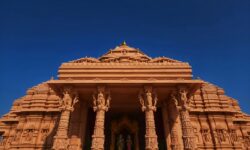
Uttarakhand, the “Land of the Gods,” is more than just a spiritual destination. It’s a trekker’s paradise, offering some of the most scenic trails in the Indian Himalayas. From beginner-friendly forest trails to high-altitude alpine adventures, trekking in Uttarakhand brings you face-to-face with snow-clad peaks, remote villages, dense forests, and serene meadows.
In this guide, we’ll walk you through the top trekking routes in Uttarakhand, local tips from seasoned hikers, the best time to visit, and what makes each trail special.
1. Kedarkantha Trek – A Snowy Winter Delight
Altitude: 12,500 ft
Best Time to Visit: December to April
Difficulty Level: Easy to Moderate
The Kedarkantha trek is one of the most popular choices for trekking in Uttarakhand, especially in winter. Blanketed in snow, the trail offers breathtaking views of peaks like Swargarohini, Bandarpoonch, and Black Peak.
The trail starts from the quaint village of Sankri, winding through dense pine forests, open meadows, and frozen lakes. What makes this trek ideal for beginners is the steady ascent and well-marked path. The sunrise from the Kedarkantha summit is nothing short of magical.
Local Insight: Stay in homestays at Sankri to experience warm hospitality and traditional Garhwali meals.
2. Valley of Flowers Trek – Nature’s Painted Canvas
Altitude: 14,100 ft
Best Time to Visit: July to September
Difficulty Level: Moderate
A UNESCO World Heritage Site, the Valley of Flowers is a botanical wonderland tucked in the Chamoli district. The monsoon transforms this valley into a vibrant carpet of wildflowers. With over 300 species of alpine flora, it’s a favorite for nature lovers and photographers.
The trail begins at Govindghat and passes through Ghangaria. It’s well-maintained, making it accessible for most trekkers.
Local Insight: Combine the trek with a visit to Hemkund Sahib, a sacred Sikh shrine located at 15,200 ft, just a few kilometers above Ghangaria.
3. Har Ki Dun Trek – Into the Cradle of the Himalayas
Altitude: 11,675 ft
Best Time to Visit: April to June & September to November
Difficulty Level: Moderate
Har Ki Dun, meaning “Valley of Gods,” offers a trek that’s steeped in mythology and beauty. This cradle-shaped valley lies below the majestic Swargarohini peak and is dotted with ancient villages, terraced farms, and thick pine forests.
This 7- to 9-day trek starts from Sankri and is ideal for those looking for a peaceful trail with cultural richness. It’s also one of the few treks where you can meet locals who still practice age-old traditions.
Local Insight: Watch for local shepherds and their unique lifestyle. They often share stories that add a whole new layer to your trekking experience.
4. Roopkund Trek – The Mystery Lake
Altitude: 16,499 ft
Best Time to Visit: May to June & September to October
Difficulty Level: Moderate to Difficult
Roopkund is not just a trek; it’s an adventure into history. Famous for the hundreds of human skeletons found at the lake, Roopkund remains one of the most intriguing destinations for trekking in Uttarakhand.
The trail takes you through oak forests, alpine meadows (Bugyals), and glaciers. The meadows of Bedni Bugyal and Ali Bugyal are visual treats. Despite the challenges, the reward of reaching the mystery lake is unmatched.
Local Insight: Acclimatization is key. Spend a day at Bedni Bugyal before heading toward higher altitudes.
5. Pindari Glacier Trek – Glacial Glory for All
Altitude: 12,300 ft
Best Time to Visit: April to June & September to October
Difficulty Level: Easy to Moderate
The Pindari Glacier trek is perfect for those who want to experience a Himalayan glacier without the challenges of a high-altitude trek. Located in the Kumaon region, the trail follows the Pindar River through lush forests, waterfalls, and rustic villages.
Starting from Khati village, the trail is well-defined and ideal for families and first-time trekkers.
Local Insight: Interact with the people of Khati and Dwali villages — they often offer homemade food and a glimpse into Kumaoni culture.
6. Nag Tibba Trek – A Quick Himalayan Getaway
Altitude: 9,915 ft
Best Time to Visit: October to March
Difficulty Level: Easy
If you’re short on time but craving a Himalayan escape, Nag Tibba is your answer. Located near Mussoorie, it’s the highest peak in the lesser Himalayas of Garhwal.
This weekend trek is popular among Delhi and Dehradun residents. The trail is short yet scenic, with forests, meadows, and a stunning view of the Bandarpoonch range from the top.
Local Insight: Start the trek early in the morning from Pantwari village to avoid midday heat and return the same day if you’re in good shape.
7. Kuari Pass Trek – Lord Curzon’s Trail
Altitude: 12,516 ft
Best Time to Visit: March to June & September to November
Difficulty Level: Moderate
Kuari Pass offers some of the best panoramic views in the Garhwal Himalayas. Known as the “Curzon Trail” after the British viceroy who explored it, the trek provides vistas of Nanda Devi, Kamet, and Dronagiri.
The trail starts from Joshimath and winds through oak forests, snowy ridges, and wide grasslands. It’s especially beautiful in spring, when the rhododendrons bloom.
Local Insight: Plan a detour to Auli if time allows – it’s a popular ski resort and offers great cable car rides.
8. Dodital Trek – A Serene Lake Trail
Altitude: 10,000 ft
Best Time to Visit: March to June & September to December
Difficulty Level: Easy to Moderate
Dodital is a hidden gem perfect for solo travelers and couples. This calm freshwater lake is believed to be the birthplace of Lord Ganesha and is surrounded by oak, pine, and deodar forests.
Starting from Sangamchatti, the trail to Dodital and further up to Darwa Pass offers great birdwatching opportunities and quiet camping spots.
Local Insight: Carry a fishing rod — locals often catch trout in Dodital (permission may be required).
9. Gaumukh Tapovan Trek – Where the Ganges Begins
Altitude: 14,600 ft
Best Time to Visit: May to June & September to October
Difficulty Level: Moderate to Difficult
This spiritually significant trek leads to the source of the Ganges River, Gaumukh, and continues to Tapovan, a high-altitude meadow with unmatched views of Mount Shivling and Meru.
The trek begins from Gangotri and requires a permit. It’s physically demanding but spiritually and visually rewarding.
Local Insight: Hire a certified guide, as the trail beyond Gaumukh can be tricky, especially near the glacier.
10. Panch Kedar Trek – A Pilgrimage on Foot
Altitude: Varies across shrines
Best Time to Visit: May to October
Difficulty Level: Moderate
For those who want to combine spirituality with adventure, the Panch Kedar trek is unique. It covers five Shiva temples — Kedarnath, Tungnath, Rudranath, Madhyamaheshwar, and Kalpeshwar — each located at a different altitude.
This is less of a linear trek and more of a trail network. The spiritual significance and remote beauty make it a fulfilling experience.
Local Insight: Try local offerings at each temple village — many small dhabas serve home-cooked Garhwali thalis.
Tips for Safe and Memorable Trekking in Uttarakhand
- Permits & Permissions: Some treks require forest department permits. Check in advance, especially for Gaumukh and Valley of Flowers.
- Weather Watch: Conditions can change quickly. Carry rain gear and thermal wear even in summer.
- Travel Insurance: Highly recommended, especially for high-altitude treks.
- Local Guides: Hiring a local guide supports the economy and enriches your journey with regional stories and safe routes.
- Stay Eco-Friendly: Carry reusable water bottles and avoid plastic waste.
Final Thoughts
Trekking in Uttarakhand offers more than just majestic views — it’s a journey into culture, nature, and inner peace. Each trail has a different story to tell, shaped by legends, seasons, and local lives. Whether you’re planning your first Himalayan hike or returning for another adventure, Uttarakhand never disappoints.
So, lace up your boots, pack your backpack, and get ready to explore a side of India that’s raw, rugged, and refreshingly real.







